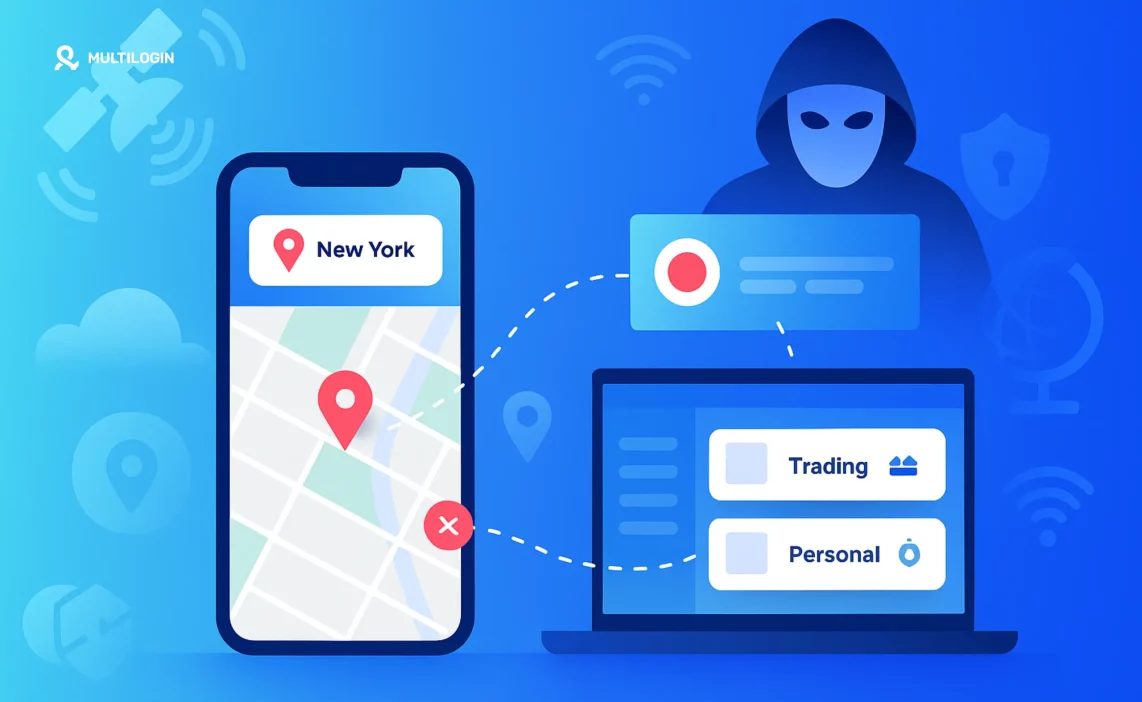Did you know that GPS signals are incredibly weak by the time they reach Earth—so weak that they can be overpowered by a cheap transmitter from a teenager’s basement?
That’s the unnerving reality behind GPS spoofing, a location deception technique that is growing more common—and more dangerous. From disrupting maritime routes to enabling app-based fraud, GPS spoofers are at the center of a growing threat to both individuals and global systems.
In this article, you’ll learn:
- What a GPS spoofer is and how it works
- Real examples of spoofing attacks
- How to detect and prevent spoofing
- How spoofing differs from GPS jamming
- What tools like Multilogin can do to protect your digital location and activity
Let’s get started.
What Is a GPS Spoofer?
A GPS spoofer is a tool (software or hardware) that generates and transmits fake GPS signals to deceive GPS receivers. It tricks devices like phones, drones, vehicles, or apps into believing they’re somewhere they’re not.
This manipulation of location data can be used for harmless purposes like testing or gaming—but it’s also increasingly being exploited for fraud, sabotage, and digital deception.
How Spoofers Work
Normally, a GPS receiver connects to a constellation of satellites and triangulates its position based on time-stamped signals. Spoofers interfere by sending false but stronger signals than those from the satellites, essentially hijacking the location calculation.
There are two main types:
- Software-based spoofers: Installed on mobile phones to simulate different locations.
- Hardware-based spoofers: Custom devices that emit radio signals to override GPS signals in an area.
These tools can alter not just position, but also time synchronization—potentially affecting financial transactions, communications, and critical systems.
Real-World Examples of GPS Spoofing
GPS spoofing is not just theoretical. It has caused major disruptions in both civilian and military contexts. Here are some notable examples:
1. Persian Gulf Shipping Incidents
Ships have reported being mysteriously transported—digitally speaking—to random inland locations. Entire fleets have shown up on GPS systems as parked at airports, hundreds of miles away from their actual position. Investigations pointed to large-scale spoofing attacks affecting commercial shipping in the region.
2. Ride-Hailing and Delivery App Exploits
Some drivers have used mobile GPS spoofing apps to make it appear they’re closer to a pickup point, thus jumping ahead in queue-based ride-hailing apps. Others use it to fake movement and game delivery systems, defrauding platforms and customers.
3. Drone Rerouting
Military drones and commercial UAVs have been hijacked by spoofers who feed them manipulated GPS data, causing them to veer off course or crash. In 2012, Iranian forces claimed to have used spoofing to capture a U.S. surveillance drone by redirecting its navigation system.
Can You Tell If Someone Is Spoofing Their Location?
In many cases, yes. But detecting GPS spoofing isn’t always straightforward because it mimics legitimate signals so effectively. However, there are signs and technical strategies that can help you identify spoofed locations.
Signs of GPS Spoofing
- Sudden, unexplained shifts in your GPS location
- Your device shows you in a physically impossible or distant location
- Inconsistent movement or travel speed
- Your map app behaves erratically or crashes
- Discrepancy between GPS and Wi-Fi/cell location data
Detection Techniques
- Signal Strength and Timing Checks: Spoofed signals are often stronger than satellite signals, which should raise red flags.
- Data Cross-Validation: Compare GPS data with Wi-Fi and cellular data. If the sources don’t match, spoofing may be involved.
- Advanced GNSS Receivers: Specialized GPS chips and antennas (like CRPA—Controlled Reception Pattern Antennas) can detect and ignore spoofed signals.
- AI & Machine Learning: Emerging solutions use AI to identify behavioral anomalies that suggest spoofing attempts.
Is Fake GPS Detectable?
Yes, especially when multiple data points are monitored.
How Devices Detect Fake GPS:
- Mock Location Checks: On Android, developers can check if mock locations are enabled.
- Sensor Data Validation: Apps can validate location using gyroscopes, accelerometers, and barometers.
- App-Level Protections: Financial, gaming, and travel apps now employ anti-spoofing SDKs that detect discrepancies and block access.
- Backend Verification: Some services validate GPS data with IP geolocation or known device behavior.
Spoofing is becoming harder to execute undetected, but it’s still very possible on unsecured systems.
Why GPS Spoofing Is a Serious Problem
While it may sound like a harmless prank, GPS spoofing has serious implications:
Navigation Safety Risks
- Spoofing can reroute planes, ships, and vehicles, leading to accidents or geopolitical tensions.
- Maritime and aviation industries rely heavily on GPS for coordination and timing.
Fraud and Scams
- Apps that reward location-based behavior—like delivery apps or fitness trackers—can be manipulated.
- Users can fake travel to take advantage of location-based offers, creating unfair advantages.
Critical Infrastructure Vulnerability
- Financial markets, telecom, and data centers use GPS signals for time synchronization. Spoofing this signal could cause misalignment, outages, or even security breaches.
Privacy Breaches
Spoofing can be used to mask illicit activities or to frame someone by faking their digital location footprint.
GPS Spoofing vs. GPS Jamming
While both interfere with GPS, they work differently.
Factor | GPS Spoofing | GPS Jamming |
Purpose | Mislead devices to wrong location | Block GPS signals entirely |
Method | Emit fake GPS signals | Transmit noise to overpower GPS |
Detection Difficulty | Harder to detect | Easier (signal disappears) |
Impact | Devices work but report false data | Devices fail to get GPS lock entirely |
Legal Status | Illegal in most countries | Also illegal and easier to prosecute |
Spoofing is generally more subtle and harder to detect, while jamming often results in total signal loss.
How to Prevent GPS Spoofing
While spoofing can’t always be prevented 100%, many steps can be taken to mitigate the risk.
For Developers and Businesses
- Use location integrity APIs that verify GPS data against other sources.
- Validate device behavior with additional sensors (motion, orientation, Wi-Fi).
- Monitor for anomalous patterns in data—sudden large jumps or high-speed location shifts.
- Invest in encrypted GNSS systems like Galileo’s OS-NMA (Open Service Navigation Message Authentication).
- Deploy anti-spoofing GNSS receivers and AI-powered anomaly detection tools.
For Android Users
- Disable mock locations in Developer Settings.
- Avoid installing unknown or modded apps that request location access.
- Use apps that verify and validate GPS using multiple sensors and networks.
- Be cautious about rooting your device, which makes it more vulnerable to spoofing.
Where Multilogin Fits In
While GPS spoofers manipulate satellite signals, there’s a smarter, more ethical way to manage location and identity online—Multilogin.
Multilogin is a privacy-first antidetect browser that helps you:
- Mask your digital fingerprint
- Simulate different geolocations safely using trusted proxies
- Run multiple accounts without cross-contamination
- Conduct web scraping or ad verification without getting flagged
Unlike GPS spoofers, which are often detectable and illegal, Multilogin operates within legal boundaries and simulates real, organic user behavior across different profiles. It’s a better alternative for anyone who needs location masking or multiaccount management—especially in sensitive industries.
Take Control of Your Location Privacy—The Smart Way
Don’t rely on outdated or risky spoofing apps to manage your identity or simulate locations.
Frequently Asked Questions About What Is a GPS Spoofer
Redirecting a commercial drone to land in the wrong location using false GPS signals is a classic example.
Yes. Mobile apps and backend systems can detect fake GPS using cross-checks, device integrity checks, and machine learning models.
In most jurisdictions, yes—especially when used for malicious or fraudulent purposes.
Disable mock location settings, use apps that verify location from multiple sources, and don’t install spoofing apps.
Spoofing sends fake data, while jamming blocks the signal. Spoofing is more deceptive, jamming is more disruptive.
Stay One Step Ahead of Location Fraud
GPS spoofing might sound like a niche concern, but it touches everything from logistics and navigation to national security and personal privacy. As digital systems become more reliant on location data, spoofing attacks will only increase in sophistication.
Understanding how spoofing works—and how to protect against it—is no longer optional. It’s essential.



